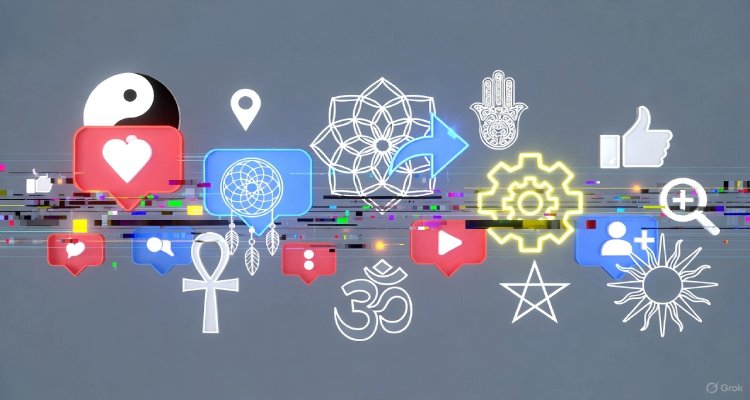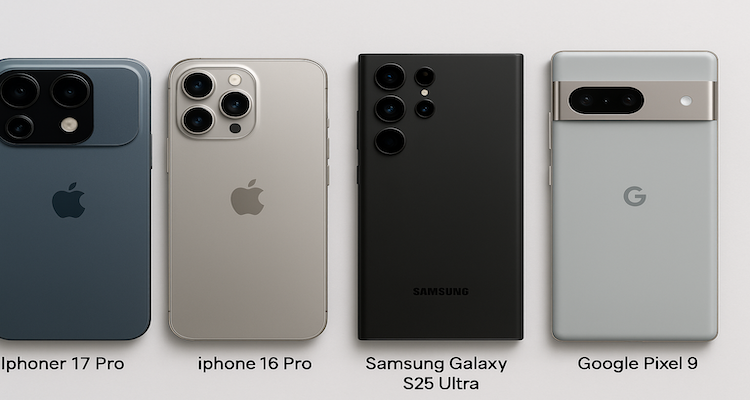iPhone 17 Pro vs iPhone 16 Pro: The Biggest Upgrades and How It Stacks Up Against Samsung & Google
Apple’s iPhone 17 Pro launch delivers big upgrades in design, performance, and battery. Here’s how it compares to the iPhone 16 Pro, Galaxy S25 Ultra, and Pixel 9 Pro.
Introduction: Apple’s High-Stakes Upgrade Moment
Apple’s “Awe-Dropping” event has finally arrived, and anticipation is soaring as the iPhone 17 Pro prepares to take the spotlight. With leaks and industry chatter setting expectations, the upcoming flagship is poised to deliver meaningful upgrades over last year’s iPhone 16 Pro. But the competition in 2025 is fierce: Samsung’s Galaxy S25 Ultra and Google’s Pixel 9 Pro have already raised the bar in performance, cameras, and AI-driven features.
For iPhone loyalists, the key question is simple: Are the upgrades worth it? And for anyone still undecided, another question looms: How does Apple’s newest Pro measure up against its biggest rivals?
Context: The End of the iPhone 16 Pro Era
Apple has a long history of trimming its lineup with each new release. This year, industry insiders expect the iPhone 16 Pro and 16 Pro Max to be quietly discontinued, nudging consumers toward the iPhone 17 Pro and Pro Max models. That means anyone planning an upgrade will have fewer options in the Pro category, effectively making the 17 Pro Apple’s flagship workhorse for the next cycle.
The 5 Biggest iPhone 17 Pro Upgrades
1. Design Evolution: Subtle but Significant
Apple’s design philosophy has always been incremental, but the iPhone 17 Pro could mark a noticeable shift. A redesigned camera bar—part glass, part aluminum—adds a modern, industrial feel, while a slightly thicker body reinforces durability.
By contrast, the iPhone 16 Pro leaned on a lightweight titanium frame, prized for portability. While titanium may feel more compact in hand, Apple seems to be betting that users will appreciate sturdiness and visual distinction over slimness this year.
How rivals compare:
-
Galaxy S25 Ultra: Samsung continues its angular design with a polished armor aluminum build, balancing durability with premium aesthetics.
-
Pixel 9 Pro: Google has leaned into sustainability, using recycled aluminum and matte finishes, appealing to eco-conscious buyers.
2. Display: Tackling Glare & Sunlight
Both the iPhone 16 Pro and 17 Pro retain a 6.3-inch OLED ProMotion display, ensuring silky-smooth visuals. The game-changer? Rumors point to a new anti-reflective coating on the 17 Pro, reducing glare outdoors and adding scratch resistance.
This may not sound flashy, but for users who spend hours streaming, gaming, or working under bright light, it could drastically improve everyday usability.
How rivals compare:
-
Galaxy S25 Ultra: Samsung leads in brightness, pushing peak levels past 3,000 nits, making outdoor visibility unmatched.
-
Pixel 9 Pro: Google prioritizes color accuracy and HDR optimization, but brightness still lags slightly behind Samsung.
3. Performance: Apple’s A19 Pro Chip Takes Charge
The performance leap is where Apple makes its boldest statement. The iPhone 17 Pro is expected to debut the A19 Pro chip, paired with 12GB of RAM and a vapor cooling system. This setup promises smoother multitasking, enhanced gaming, and better thermal management—key upgrades over the A18 Pro + 8GB RAM configuration on the iPhone 16 Pro.
How rivals compare:
-
Galaxy S25 Ultra: Runs on Qualcomm’s Snapdragon 8 Gen 4 for Galaxy, featuring upgraded AI accelerators and gaming-focused GPU optimizations.
-
Pixel 9 Pro: Powered by Google’s Tensor G5, designed to integrate AI-driven tasks seamlessly, especially in photography, translation, and assistant functions.
Apple’s focus is raw performance and efficiency, while Samsung and Google lean more into AI-enhanced experiences.
4. Camera: A New Era of Optical Zoom
Photography upgrades are always headline-makers, and the iPhone 17 Pro is rumored to add a 48MP telephoto lens with up to 8x optical zoom—a massive step forward from the iPhone 16 Pro, which capped out at 3x. Alongside, the 17 Pro retains the 48MP main and ultrawide cameras for all-around versatility.
How rivals compare:
-
Galaxy S25 Ultra: Still the zoom king, boasting a 200MP primary sensor and 10x periscope zoom, making it a powerhouse for mobile photography.
-
Pixel 9 Pro: Google doubles down on computational photography, delivering crisp low-light shots and superior AI-enhanced portraits, even if hardware specs are modest.
Apple’s upgrade closes the gap but doesn’t dethrone Samsung in zoom supremacy. However, iOS integration and Apple’s editing tools will keep creators loyal.
5. Battery Life: Bigger, Longer, Smarter
Battery life has often been a sticking point for iPhones, but this year Apple is answering the call. The iPhone 17 Pro reportedly packs a 4,252 mAh battery, up from the 3,582 mAh in the iPhone 16 Pro. This bump could mean extended daily use and fewer mid-day charges.
How rivals compare:
-
Galaxy S25 Ultra: Houses a 5,000 mAh battery, optimized with Samsung’s battery health AI to stretch longevity.
-
Pixel 9 Pro: Runs slightly smaller cells but makes up for it with software efficiency, delivering reliable all-day life.
Apple still trails Samsung in raw numbers, but its efficiency-focused chipsets often squeeze impressive longevity out of smaller batteries.
Market Reaction & Expert Analysis
Early reactions on social media suggest excitement around the anti-reflective display and vapor cooling system. Analysts also point out that Apple’s design changes, though subtle, are meant to visually separate the iPhone 17 Pro from its predecessor something crucial as smartphone innovation plateaus.
Industry experts argue that while Samsung and Google are flexing AI-driven experiences, Apple continues to prioritize hardware refinement and ecosystem cohesion. This means iPhone buyers aren’t just purchasing a device; they’re locking into a seamless Apple environment where every upgrade feels interconnected.
Impact & Implications: What This Means for Buyers
The iPhone 17 Pro may not introduce groundbreaking changes, but the combination of faster performance, improved cameras, stronger battery life, and subtle design tweaks makes it a compelling package. Apple’s decision to phase out the 16 Pro also signals a push to keep customers on the cutting edge whether they’re ready or not.
For cross-platform shoppers, the Galaxy S25 Ultra and Pixel 9 Pro remain strong alternatives:
-
Choose Samsung if photography versatility and screen brilliance are your top priorities.
-
Choose Google if you value AI-driven features and software-first experiences.
-
Stick with Apple if you want performance, battery balance, and deep ecosystem integration.
Conclusion: Should You Upgrade to the iPhone 17 Pro?
For iPhone 16 Pro owners, the decision depends on priorities. If you’re happy with your current performance and don’t need enhanced zoom or better battery, holding off another year may make sense. But if you crave Apple’s latest power, durability, and photography improvements, the iPhone 17 Pro represents one of the most well-rounded upgrades in years.
In the broader landscape, Apple’s move shows one thing clearly: while rivals fight for AI dominance, Apple is betting on refined performance and longevity a strategy that has kept it at the top of the premium smartphone game.
iPhone 17 Pro vs iPhone 16 Pro vs Galaxy S25 Ultra vs Pixel 9 Pro
Feature |
iPhone 17 Pro |
iPhone 16 Pro |
Samsung Galaxy S25 Ultra |
Google Pixel 9 Pro |
Design |
Glass + aluminum build, thicker with new camera bar |
Titanium frame, lighter, compact |
Armor aluminum, angular, durable |
Recycled aluminum, matte eco-friendly design |
Display |
6.3” OLED, ProMotion, anti-reflective coating |
6.3” OLED, ProMotion |
6.8” AMOLED, peak 3000+ nits brightness |
6.7” OLED, HDR-optimized, high color accuracy |
Chipset / Processor |
A19 Pro chip, 12GB RAM, vapor cooling |
A18 Pro, 8GB RAM |
Snapdragon 8 Gen 4 for Galaxy, AI-optimized |
Google Tensor G5, AI-driven performance |
Camera |
Triple-lens: 48MP main + 48MP ultrawide + 48MP telephoto (8x zoom) |
Triple-lens: 48MP main + ultrawide + 3x telephoto |
Quad-lens: 200MP main + 10x periscope zoom |
Triple-lens: 50MP main + AI computational photography |
Battery |
4,252 mAh |
3,582 mAh |
5,000 mAh with AI battery optimization |
~4,800 mAh, efficient via software |
Special Features |
Anti-glare display, improved thermal cooling |
Compact titanium build |
S Pen support, best-in-class zoom |
AI-first photography & assistant features |
Ecosystem Strength |
Seamless iOS integration, Apple ecosystem |
iOS ecosystem |
Deep Samsung ecosystem + Galaxy AI |
Google services + AI ecosystem |
Upgrade Appeal |
Balanced power, durability, and camera leap |
Strong but aging |
✅ (Disclaimer: This article is based on leaks, expert commentary, and market speculation ahead of Apple’s official announcement. Final specifications will be confirmed during the launch event.)











